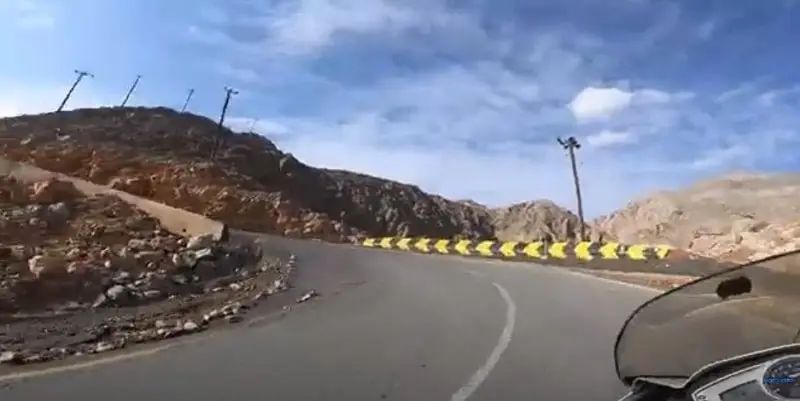When confronting a steep downhill bend, it may appear intimidating – a stretch so daunting that even strolling down can be challenging. Initially, these bends filled me with trepidation.
But today, they rank among my preferred turns on this route. So, how can a steep, unpleasant, downhill, hidden, and decreasing radius bend transform from being terrifying to enjoyable?
Why is an uphill bend invigorating while a downhill bend isn’t? The response to these questions is quite simple: Gravity.
Gravity: A Blessing and a Curse
Gravity is our ally when going uphill, aiding us in managing our speed and contact patch more precisely.
If anxiety sets in, a simple reduction in throttle or even letting off the throttle completely can slow the bike until we reach a comfortable speed.
It sounds simple. However, the same gravity makes descending more demanding, pulling us downhill.
Controlling speed becomes a Herculean task when going downhill. Easing off the throttle may not considerably reduce the bike’s speed.
If you’re a staunch believer in the “complete all your braking before the corner” philosophy, this scenario presents a formidable challenge.
To accelerate or even maintain throttle through a downhill curve, we have to drastically reduce our entry speed to prevent excessive speed before the turn’s end.
The Art of Front Braking
The key to managing speed in downhill curves is effectively utilizing the front brake. Champ School highlights it best: compared to ascending the canyon, descending it requires 100% more braking.
But isn’t there a risk that applying the front brake will cause the front tire to skid? It’s impossible to control every factor – a spilled diesel patch in the curve can pose a risk, irrespective of front brake usage.
However, applying the front brake won’t cause a skid if done right. The trick is to lightly drag the front brake, applying and releasing pressure in small amounts to control speed to our satisfaction.
Debunking the Myth of Front Braking and Turning

There’s a common misconception that using the front brake while cornering causes the bike to drift wide. But this isn’t true.
Abruptly grabbing the brake during a turn can indeed lead to unpredictable outcomes. However, that’s not what we’re advocating. The idea is to gently drag the front brake to regulate our speed and assist the bike in turning.
Applying the front brake while going downhill shifts our weight to the front tire, causing the front forks to compress. This reduces our bike’s rake and trail, aiding in changing its direction.
Suspension and Braking
There might be a concern that using the front brake in a turn could max out our suspension, leaving nothing for bumps.
In reality, if light braking causes your bike’s forks to bottom out, it’s high time to visit your local mechanic. Remember, the objective here is to get the forks to compress slightly, helping the bike to turn. The brake pressure applied should be minimal, maybe around 5%.
Throttle and Braking – The Incompatible Duo
A common notion among riders is that applying gas stabilizes the chassis during a turn. So, does this mean we should be on the gas and brakes simultaneously?
Definitely not. One golden rule in riding is never to overlap the throttle and the front brake.
The Case for Front Braking Over Rear Braking
Can’t we just use the rear brake instead? Yes, you can, but the front brake is far more effective. When we decelerate, the weight transfers to the front tire, increasing its grip and reducing that of the rear.
Also, we can more accurately regulate the pressure with our hands than with our feet.
Tackling the Steep Downhill Bend
Navigating any downhill bend, especially a steep one, is inherently challenging. Even though it contradicts popular belief and teachings, using our front brake in bends is not only permissible but recommended – it’s precisely how our motorcycles are designed and engineered to operate.
Fine-Tuning Brake Usage
The key is the mindful application of our front brake, with smooth, progressive inputs. As we ride, we must maintain concentration on our present situation.
Downhill turns are tough. It’s advisable to approach them from the outside, within reasonable limits of course. A wider approach grants us better visibility into the turn and makes it less sharp.
Being in Control
We have the final say in determining our speed. We can regulate it according to our comfort, adding a bit more brake pressure if we feel too fast.
Be aware of potentially hazardous traffic in extremely tight bends, keeping the bike away from the road’s center.
Taking Good Decisions
Your safety is paramount, much more than conserving brake pads or money. Once you can see your exit and lessen the bike’s lean angle, you may need to further release the brake pressure and let your speed increase naturally.
Downhill Mastery
Conquering downhill curves, especially steep ones, requires a straightforward technique, albeit not easy: Keep the throttle closed and stick with the front brake, subtly adjusting the pressure to control your speed until you’ve successfully made the turn.
Let’s discard the antiquated 1970s riding techniques. Instead of hoping we’ve slowed down sufficiently, the bend isn’t too steep, or we can lean over far enough, let’s evolve into technical riders who can precisely manage our speed. Let’s master control with our most potent and versatile tool – our front brake.

